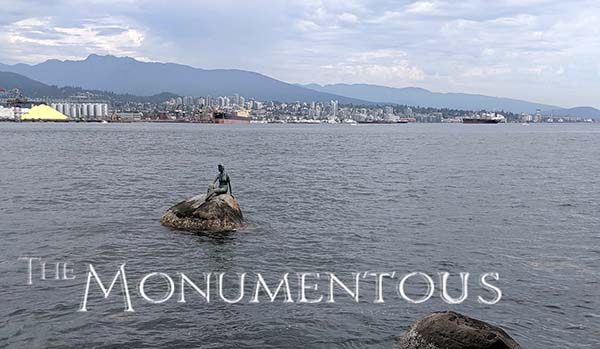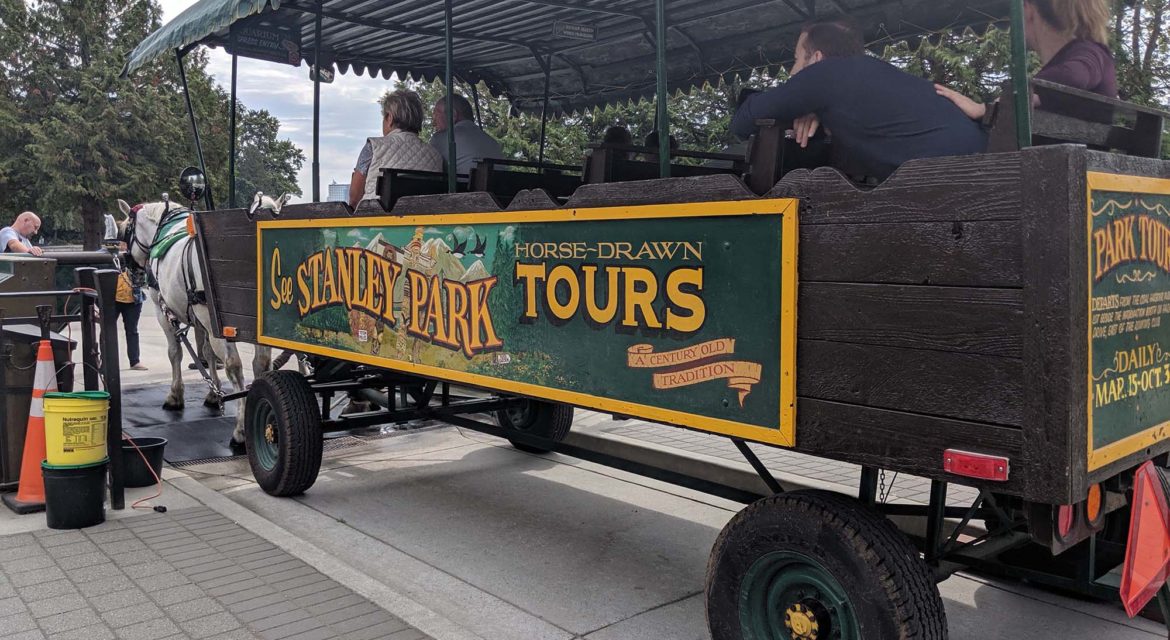 Stanley Park borders the downtown of Vancouver in British Columbia, Canada and has become one of the most notable attractions in the region. Located on a peninsula that is surrounded by waters of Burrard Inlet and English Bay, the park transitioned from a forest into an urban space over many years. In the process of doing so it has become Vancouver’s first, largest, and most beloved urban park.
Stanley Park borders the downtown of Vancouver in British Columbia, Canada and has become one of the most notable attractions in the region. Located on a peninsula that is surrounded by waters of Burrard Inlet and English Bay, the park transitioned from a forest into an urban space over many years. In the process of doing so it has become Vancouver’s first, largest, and most beloved urban park.
The over 400-hectare natural West Coast rainforest contains numerous monuments and activities designed to appeal to both residents and tourists. The wide range of experiences for all ages and interests have had a notable impact on the culture of Vancouver and economy of the region.

From a Forest into an Urban Park
The peninsula that Stanley Park resides on has been a history that stretches back thousands of years, with evidence of villages that were home for many Squamish, Musqueam and Tsleil-waututh people. Spanish Captain José María Narváez and British Captain George Vancouver explored the area in the1790s, while non-Indigenous settlers began to move into the area in the 1850s. The land was later turned into Vancouver’s first park when the city incorporated in 1886. The Shore to Shore monument is a tribute to the ancestral connection between the area’s aboriginal and Portuguese communities.
 On September 27, 1888, Stanley Park was officially opened and named after Lord Stanley, who had recently become Canada’s sixth governor-general. Stanley dedicated the park “To the use and enjoyment of people of all colours and creeds and customs for all time” which is displayed on a statue that bears his likeness.
On September 27, 1888, Stanley Park was officially opened and named after Lord Stanley, who had recently become Canada’s sixth governor-general. Stanley dedicated the park “To the use and enjoyment of people of all colours and creeds and customs for all time” which is displayed on a statue that bears his likeness.
Over the years numerous attractions and features were installed across the Park. Those include the construction of a seawall and walkway around the park began in 1917 and took several decades to complete, two seaside pools, the Stanley Park Zoo as well as the Vancouver Aquarium. These developments gradually saw the space transformed from a forest into an urban park.
The aquarium has become a major tourist attraction for Vancouver as well as a center for marine research, conservation and marine animal rehabilitation. Stanley Park is also home to numerous activities and monuments, all of which provide visitors with a wide range of experiences for visitors of all types and ages.

From Beaches to Robert Burns to Playgrounds
 The 405-hectare (1,001-acre) public park has activites that appeal to both tourists and local residents. The Vancouver Aquarium is Canada’s largest aquarium, while beaches, miles of well-maintained paved and dirt trails keep visitors busy no matter where they’re coming in from or how long they’re planning to be at the site.
The 405-hectare (1,001-acre) public park has activites that appeal to both tourists and local residents. The Vancouver Aquarium is Canada’s largest aquarium, while beaches, miles of well-maintained paved and dirt trails keep visitors busy no matter where they’re coming in from or how long they’re planning to be at the site.
A string of beaches line Stanley Park, but only two are accessible for swimming. Second Beach, on the park’s southeastern coast, boasts the popular Second Beach Pool, a heated, outdoor pool with magnificent views of English Bay and the west side of Vancouver. Third Beach is somewhat seculted and also located on the park’s southern coast. It features a sandy beach and beautiful views of the sunset.
The playground at Ceperley Meadow near Second Beach was built in the 1920s and features a seafaring theme. There are also playgrounds near Lumberman’s Arch and the Stanley Park Pavilion. Stanley Park also has a number of monuments, including statues, plaques, and gardens.
Brockton Point features the 9 O’Clock Gun, which fires every day at 21:00. It also contains a lighthouse, designed by Thomas Hayton Mawson, which was built in 1914 to replace one built in 1890. The First Nation Totem Poles at Brockton Point have been identified as the most-visited tourist attraction in all of British Columbia.
 Out on the water, Girl in a Wetsuit is a life-size 1972 bronze sculpture of a woman in a wetsuit, which is similar in form and placement to another famous iconic sculpture. Near there resides the RMS Empress of Japan, which is a replica figurehead of what was once the fastest ship on the Pacific that operated between 1891 and 1922.
Out on the water, Girl in a Wetsuit is a life-size 1972 bronze sculpture of a woman in a wetsuit, which is similar in form and placement to another famous iconic sculpture. Near there resides the RMS Empress of Japan, which is a replica figurehead of what was once the fastest ship on the Pacific that operated between 1891 and 1922.
There are also numerous notable statues throughout the park. A sculpture of Lord Stanley by Sydney March was unveiled in 1960, while the Robert Burns Memorial is an outdoor memorial and statue of Scottish poet Robert Burns. Dedicated in 1928, it was the first statue ever erected in Vancouver.
These are just some of the many attractions and points of interest in Stanley Park, all of which have helped it to enable a notable impact on the culture of the city and region.

Epitomizing Vancouver’s Love of the Outdoors
As the most famous landmark in Vancouver, Stanley Park has come to epitomize Vancouver’s love of the outdoors which is why it appears on just about every “things to do” list for visitors. Numerous physical and digital maps of the city highlight Stanley Park and showcase the numerous monuments and activities that it contains.
 While these monuments and attractions pull in tourists by the million, annual events that take place in Stanley Park have a special appeal to visitors. Those vents inlcude the Polar Bear Swim, Vancouver Sun Run, BMO Vancouver Marathon, Easter Fair and Miniature Train, Stanley Park Open Tennis Tournament, Celebration of Light Fireworks and Festival, Vancouver Triathlon, Terry Fox Run, Halloween Ghost Train, and Bright Nights Christmas Train. There are also many one-time concerts, charity walks and runs, workshops, and Walking Tours that take place throughout the year in Stanley Park.
While these monuments and attractions pull in tourists by the million, annual events that take place in Stanley Park have a special appeal to visitors. Those vents inlcude the Polar Bear Swim, Vancouver Sun Run, BMO Vancouver Marathon, Easter Fair and Miniature Train, Stanley Park Open Tennis Tournament, Celebration of Light Fireworks and Festival, Vancouver Triathlon, Terry Fox Run, Halloween Ghost Train, and Bright Nights Christmas Train. There are also many one-time concerts, charity walks and runs, workshops, and Walking Tours that take place throughout the year in Stanley Park.
As an example of the Park’s direct connection to the community, the Stanley Park Ecology Society promotes awareness of, and respect for the natural world. It plays a leadership role in the stewardship of the park through collaborative initiatives in education, research and conservation. There are many fun programs for all ages to take part in, and the Society promotes visitation from anyone.
To highlight the park’s importance to the region and even Canada as a whole, Stanley Park was designated a National Historic Site of Canada by the federal government in 1988. It was deemed significant because the relationship between its “natural environmental and its cultural elements developed over time” and because “it epitomizes the large urban park in Canada.”
These are just some of the examples of how the wide range of activities at Stanley Park that have enabled a powerful economic impact for the Park and for Vancouver as a whole.

The Economic Impact of Stanley Park
The most inclusive stop for general info about Stanley Park is the information booth just inside the Georgia Street entrance. Numerous items are available for purchase at this location, although many more are for sale at the Brockton Visitor Centre, which also offers interpretive panels about the history and culture of the Coast Salish people as well as access to the famous First Nations totem pole display. Additionally, there are numerous and notable items to purchase in the gift shop that are associated with the Totem poles at Brockton Point.
 The Stanley Park Horse-Drawn Tours are offered from March through October. The one-hour tours are relaxing and educational as passengers learn about the park and its surroundings with a route that takes in many of the more popular spots.
The Stanley Park Horse-Drawn Tours are offered from March through October. The one-hour tours are relaxing and educational as passengers learn about the park and its surroundings with a route that takes in many of the more popular spots.
Numerous restaurants are located throughout Stanley Park, and they range from the upscale divine to the quick and casual. The Teahouse serves fine-dining fare in an exceptional setting while Stanley’s Park Bar & Grill, which features an immense patio that juts out from the Stanley Park Pavilion and can seat about 200.
Countless tour businesses have been built around Stanley Park as well, creating jobs and economic opportunity in Vancouver. Most of the tours are seasonal during the summer months, but some operate in the off-season and all year long. There are also a number of historical, First Nations, and foraging walking tours in Stanley Park during the summer months. There is even a photography tour on which someone can tour Stanley Park and improve their photography skills at the same time.
These economic activities allow Stanley Park to maintain its’s appearance and appeal. However, it’s also possible to directly support Vancouver’s first urban park by making a donation to protect Stanley Park.
It’s impossible to quantify the economic impact of the approximately 8 million visitors that come to Stanley Park each year. That activity has made it one of Vancouver’s main tourist destinations. In doing so, the site represents what it can mean for a park to create a legacy that defines the present and future of a region.

The Greatest Urban Park in the World
 Having been named the best park in the world in 2013 and beating such notable locations like Central Park in New York as well as the Garden of the Gods in Colorado, Stanley Park has made a claim to be one of the greatest urban parks in the world. The economic and cultural ramifications of that development continue to be felt throughout the park and city.
Having been named the best park in the world in 2013 and beating such notable locations like Central Park in New York as well as the Garden of the Gods in Colorado, Stanley Park has made a claim to be one of the greatest urban parks in the world. The economic and cultural ramifications of that development continue to be felt throughout the park and city.
What could have otherwise just been a glorified forest outside of Vancouver has been turned into something monumentous thanks to a collection of monuments, activities and attractions that provide both residents and tourists with something to do. That has enabled Stanley Park to create a legacy that will continue to attract visitors by the millions and have a positive impact on Vancouver in the present and future.

